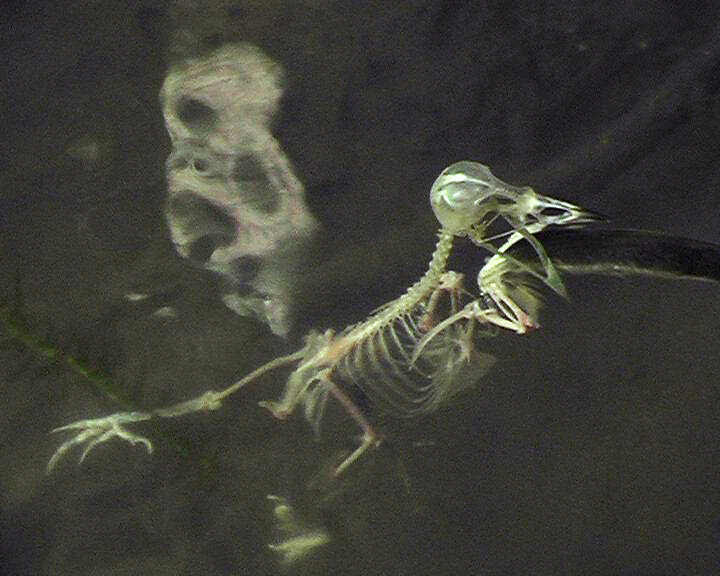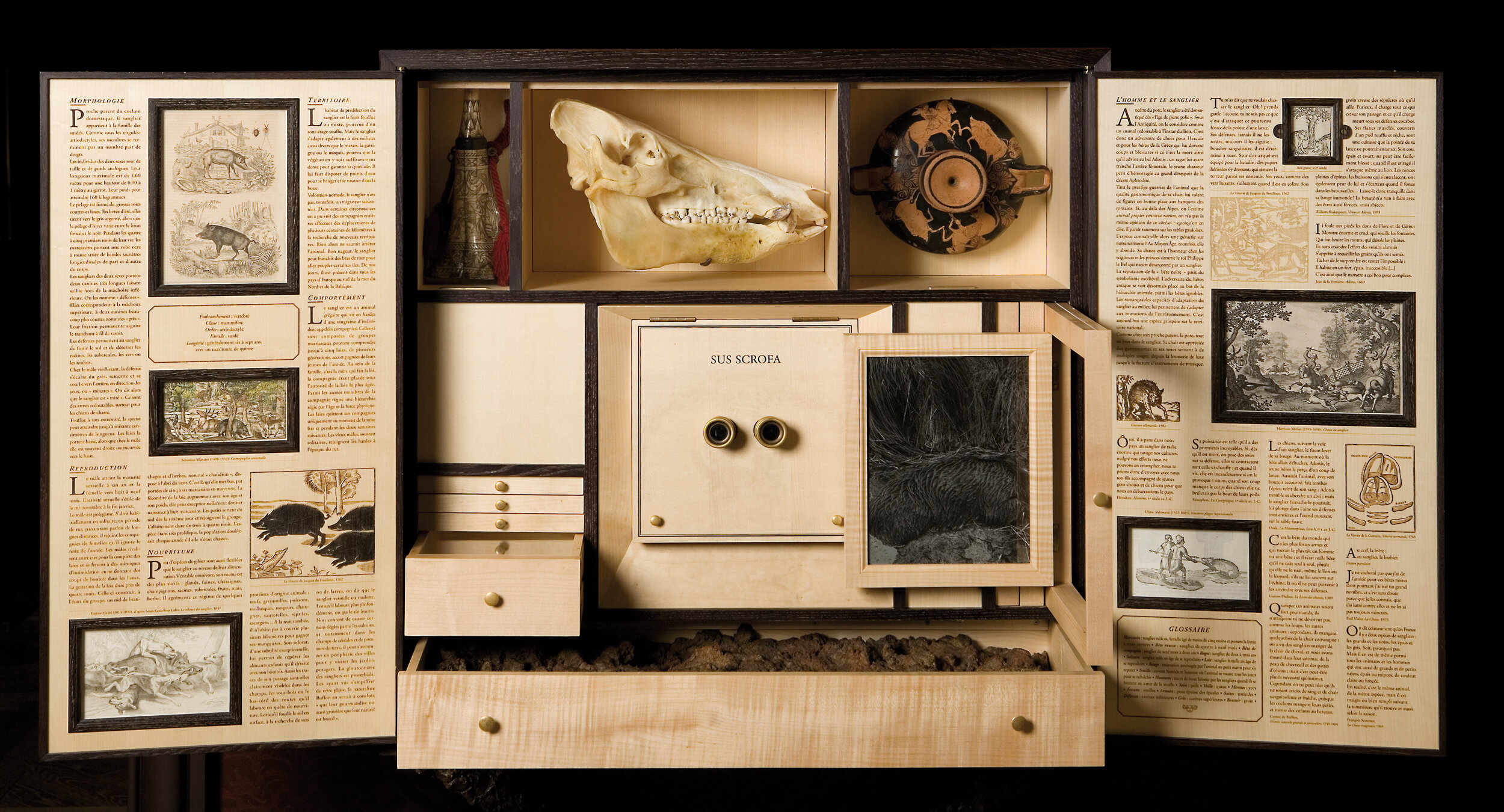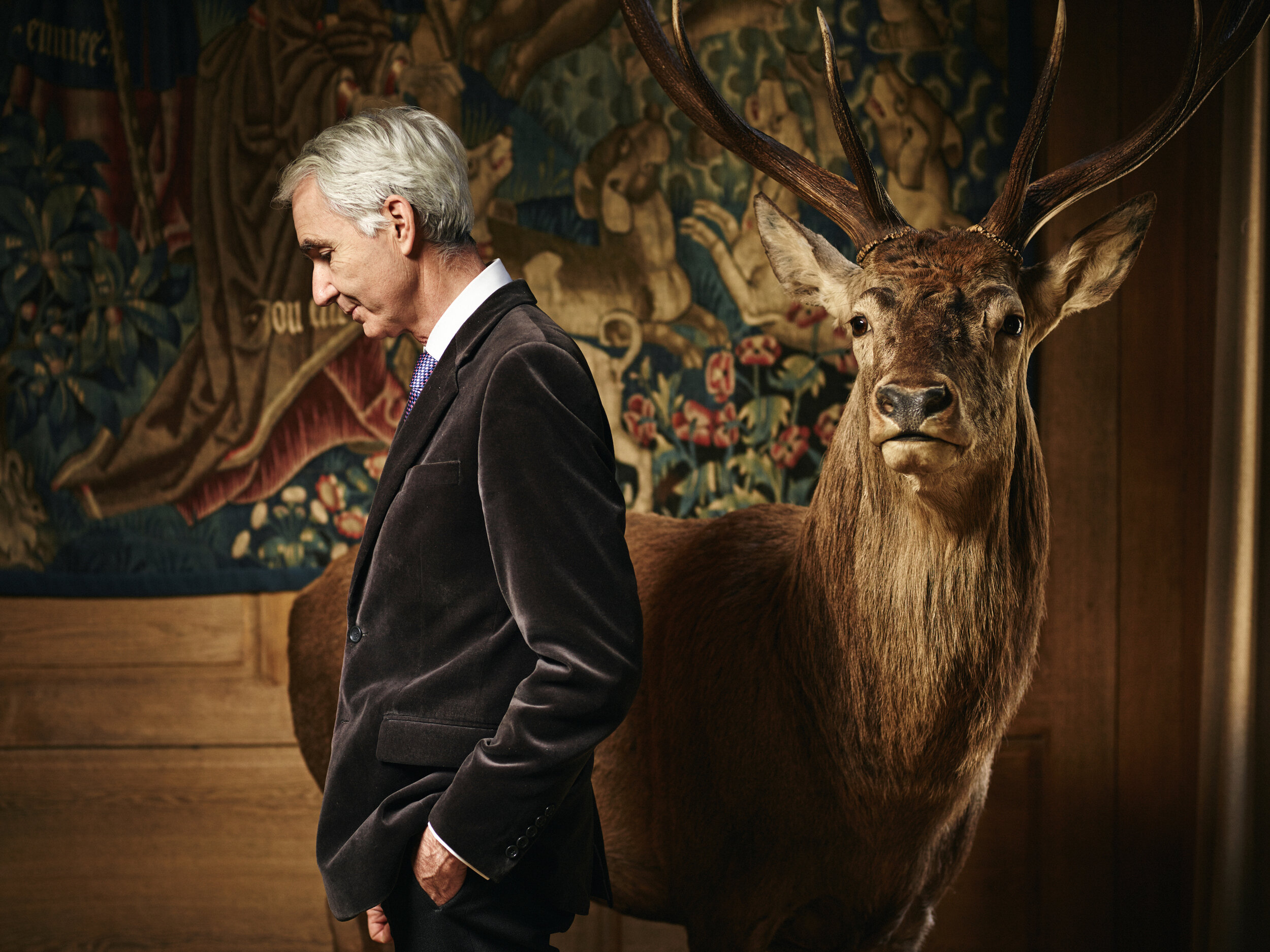Reenchantment
Musée de la Chasse et de la Nature | Museum of Hunting and Nature
Above number 62 Rue des Archives in the Marais hangs a black metal sign that reads, humbly, just musée. But once you step beneath it, and through the porte-cochère and its enormous blue doors, you find yourself in a courtyard with 18th-century walls rising up to meet you. This is the Hôtel de Mongelas, a residence designed in 1705 by Antoine Fouquet and which, over three centuries, has been home to families, nobles, and artisans.
Today it houses the Musée de la Chasse et de la Nature, the Museum of Hunting and Nature, one of the most transportive and singular places in Paris. Dedicated, uniquely, both to art and conservation, it's an aesthetic exploration of our relationship to nature and the wild. Its rooms are now shadowy, mythical domains—the Cabinet of the Unicorn; the Salle du Sanglier, or wild boar; and the Salon des Oiseaux—where natural specimens are installed alongside medieval artwork and pieces by contemporary artists, creating an uncanny and otherworldly atmosphere.
The visionary at the center of it is Claude d’Anthenaise. As director and curator from 1998 to 2019, he shaped a space where ancient and modern breathe the same air, and where artists and musicians, ecologists and witches gather to explore ideas inspired by the natural world. Before he left his post in 2019 to embark on a new project, we spoke with d’Anthenaise in the museum's offices in Paris.
A: You shared that your mission for the museum was to make “a museum of emotion,” with “a free and poetic spirit,” and “a climate of strangeness.” These are very Romantic ideals. Why did they drive you?
CDA: I think the main aim as director of the Musée de la Chasse et de la Nature is to suggest, to help to create a kind of spark of creative emotion for the visitor. I wanted to suggest that visitor when entering the museum would be in the same situation as if he were arriving in a forest, or coming into the wild. Losing his own marks to arrive somewhere where everything is new, and not immediately understandable.
A: It's interesting to note though, you also came to the project with a great deal of rigor, having been responsible for the conservation and restoration of national monuments.
CDA: Yes, I was especially interested through my experience as Inspecteur des Monuments Historiques in the question of the intercession of works of art in architecture. The relation between works of art and space. I don't want to be pretentious, but a bit like a metteur en scène, there is a bit of this aspect.
A: Do you feel that spaces have an inherent atmosphere or energy to them? Or do you feel that this is something that a visitor projects onto it, in terms of any space?
CDA: No, of course, you don't behave in the same way when you are in a Roman church or a contemporary building like La Défense or modern surroundings. No, no, I think there is a very deep influence of the place where you stay and your ideas, your mind, and so on. So we had the opportunity to set the museum in two very nice buildings, one is from the 17th century, the other one is 18th century, so you have all this past. I think it's a good place to work with contemporary art, because the roots of what we are now are precisely expressed this through this architecture, all these elements of the past.
A: You've written that you wanted a poetic navigation, or a naturalistic plan, with no barriers. How did you go about achieving that, or rather allowing that?
CDA: Through my own experience, I realized that in many museums which were done recently in the 80s or 90s, everything is done for the comfort of the visitor. All the pedagogic tools, for example, are exactly the same from one room to another room, they are situated in the same place. So when you enter a room, you have no question, no problem—you know what you will find and where you will find it, how you have to interpret the works of art or the elements which are presented to you. And this, I think is something which can kill completely emotion, because you are like on a motorway where nothing will occur, you are completely safe, and I think you shouldn't be safe when you enter a museum—it’s a place which has change you, change your mind, and change your ideas.
A: Because when you do spend time with all of these spaces, you are entering these other realms of myth and magic and fable and natural history, all of these dimensions that you've intertwined.
CDA: I think in western countries we developed a special culture and a special image of nature as if as humans we are not part of nature, we are outside of nature. And this conception of nature has many backgrounds: scientific background, philosophic, artistic. Actually, we always create images to help us to deal with nature, but we are also in a way prisoners of these images. And in the actual crisis of the Anthropocène, and all these questions with the environment, we need to create new images of nature, to change our behavior. And I think it's the aim of the museum to help visitors to create these new images. And I think now our time is rediscovering the complexity of the world, and the question of hybridization, mixity, is something which is completely new and very rich for the way we will behave. So that’s one thing I wanted to express in the museum.
d’Anthenaise’s philosophy speaks to our current cultural drive to reintegrate with nature. The focus of exhibitions, literature, film, and making, our connection with the wild places is conjured up in books like Robert Macfarlane’s magnificent Underland and The Lost Spells, in the practices of herbalism and wildcrafting, and in exhibitions like the Fondation Cartier’s recent show, Les Arbes | The Trees, which was so successful it extended its run.
CDA: I think we are trying to réenchanté le monde. And for example, we are working now on the extension of the museum, and we will focus on the question of shamanisme, because I think it is one aspect that we have completely hidden in western culture because it was against the scientific approach. And I think now, one challenge for us is to try to reintroduce this kind of communication between species, between elements of nature, and the scientific approach. It's something which is very difficult because we have to change our mind, to change our images. And I think in a very modest way, the Musée de la Chasse can help to support this new approach.
A: And the shaman is, tell me if you agree, a wonderful figure to represent that because the shaman was originally both naturalist and spiritual leader; because they were herbalists, but also sages. So that's a wonderful metaphor for reconnecting with the sensual, and bringing those two worlds together.
CDA: Recently we organized a speech on écoféminisme and sorcières that was extremely successful—we had like a thousand visitors and people who wanted to attend the conference. And I think this is an interesting approach because, probably for centuries, we had a very male conception of nature which went with a kind of separation between human and nature—domination and exploitation—and now, we are trying to support another approach where people will deal differently with nature. Like the idea of prendre-soin, prendre-soin la nature, to take care. And I want to support this idea In the organization of the exhibitions.
The museum goes beyond physical landscapes to explore psychological ground through fable and myth. The epigraph of A Singular Museum, the wonderful little guide to the musée, opens with a quote from a 17th-century French fairytale, le petit Poucet: “Because as he walked, he dropped little white pebbles from his pockets all along the way.” It speaks not only to the poetic navigation of the galleries that d’Anthenaise has created, but to the archetypal stories that inform the museum. Here, he shares how the fable of Goldilocks was a symbolic narrative for him as he created a museum that inverts traditional perspectives; where we are observed by animals, and cross into their dominion.
Translation: “We realize that the inhabitants of the house are returning, and that the inhabitants are bears. It creates a moment of great tension. We can open the drawer, but it's not completely permitted. It's a little transgressive because in a museum you don't touch; here, you take ownership of a house that is not yours.”
A: So it's this wonderful idea of rebellion and kind of transgression in a space like a museum where you're not typically supposed to touch anything, and you're in someone else's space or territory.
…When we return, d’Anthenaise introduces magical objects and works of art…
A: So when we talk about reenchantment, there is so much magic In the atmosphere at the museum, not only in its spaces, but in its objects. You have apotropaic and otherworldly objects like the narwhal horn, the bezoar. Would you tell us about one or two of your favorites of these special pieces?
CDA: Yes, talking about reenchantment, I think it’s very important to let the visitors imagine what they have under the eyes, and to assimilate it. And one great experience I had a few months after the opening of the museum, was to see a young boy—I think he was eight years old, something like that—watching at the cabinets, which are focused on special animals. And at this cabinet, you can find everything you want to know about the behavior or territory of these animals. And I have one cabinet which is a devoted to the fox.
Here d’Anthenaise tells the story of this boy peering into one of the museum's beautiful cabinets, which feature drawers and tiny compartments filled with specimens like skulls and horns, small artworks, and texts. Each cabinet focuses on a particular animal, the fox or the wild boar, and more intriguingly, each has a pair of binocular-like lenses one can look into to see a little film on the animal or its habitat. Looking through the spectacles at the cabinet of the fox, one sees a film of a fox’s den but, as d’Anthenaise notes, the creature itself mysteriously never appears.
CDA: I saw this young boy who was watching at the spectacles without moving. And I thought “Oh poor boy, he is very patient, so maybe I should go and tell him that the fox will not come today. He has to go again another day, then he will be probably be more lucky.” And as I was approaching him, he suddenly shouted “Oh, dad, I've seen him! I've seen his tail!” So, I think that was exactly what I wanted to do through the museum, because he created this fox which actually didn't exist through his own experience and his own imagination. And probably this meeting with a nonexistent fox was deeper and more striking for him than if I had presented real images of the fox as you can see everywhere on TV. It’s what I think is important to create a kind of enchantment of the visit.
The Musée de la Chasse is of course a cabinet of curiosities writ large. In its rooms, artworks are installed alongside vitrines housing scientific objects and taxidermies. Here, we talk with d’Anthenaise about the Rubens Study, where works by Rubens and Breughel coexist with a contemporary installation by Belgian artist Jan Fabre, The Night of Diana (2007). In this very small chamber painted ink black and half-illuminated, hang the two magnificent paintings Diana and her Nymphs (1623-24) and Diana and her Nymphs Leaving for the Hunt (1623-24), which are themselves haunted from above by Jan Fabre’s circle of owls gazing down, thousands of gray and gold feathers arrayed over the ceiling.
CDA: Actually, in the collections there were these two very important paintings, representing Diana as you told, and as you know Diana is the goddess of the hunt so she's somebody very important for the collection and for hunting culture. So I wanted to do a kind of a case for these two paintings. But I wanted to do something like what we call a reposoir. Formerly I had seen in Brussels that Jan Fabre had done a very nice ceiling with insects—he covered the ceiling with insects—and I thought he would do something in the same way. I went to see him in Anvers, and he was very interested in Diana. And I wanted to do something with owls, because for me the owl is of course the bird of the night, and it is also a messenger for death in Jan Fabre’s own mythology. And he had the idea of doing big heads of owls where he included not fake eyes like you can buy in taxidermy to do birds, but human fake eyes, glass eyes. So when you enter this room you have this very strange feeling that you are surrounded by these animals, but which look at you with human eyes. It's important because this case, this reposoir, is one of the first things that you discover when you visit the museum, and it gives the feeling for the visit of this kind of mixity and enchanted atmosphere.
A: Yes—the eeriness, the identification, all of those ideas come together in this piece really beautifully. The Unicorn Cabinet features Licorne (2006), a video by Maïder Fortuné; a wonderful piece by Janet Janine, The God of the Forest (1957)—the horned man, who could be Actaeon, or could be Cernunnous. Can you tell us a bit about the symbolism of the licorne?
CDS: When I organized the museum, I wanted to show how our relation with animals evolved from century to century, and I tried to choose animals which would be representative of one state of mind for a precise period. For example, I tried to link the wild boar with antiquity or the deer and the wolf with the medieval age, and the unicorn is very interesting, and I wanted to link it with that period where after the medieval period we enter into a kind of critique of Christian culture, which gave a symbolic interpretation of all the elements of nature, and a period also when we tried to do a kind of inventory of the world, a kind of pre-scientific approach. And at that time, people were believing in the existence of the unicorn, because important texts like the Bible and Aristotle were talking about that. So, at that time it was very uncomfortable to contest the existence of an animal which had such important proofs of its existence. It's why in the wündercabinets, the cabinets de curiosités, which were created in the late Renaissance through the 19th century, among all the objects which should take a place in the cabinet was a unicorn horn.
d’Anthenaise explains that traditionally, a wünderkammer always contained the horn of a unicorn—in fact a narwhal tusk—because it was believed that it acted as an antipoison. And lastly, he shares how, in the Unicorn Cabinet, this ancient, mythic creature is brought back to life in a contemporary work by Maïder Fortuné.
CDA: So I decided to create inside the museum, a place where many things would be a kind of testimony to the existence of all these fantastic animals. Maïder Fortuné did this very nice film, where there is a horse which is dressed as a unicorn, and which is a disappearing in a rain of ashes…
As we shared, Claude d’Anthenaise left the museum last year, entrusting it to its new director, Christine Germain-Donnat. But though he is now away, like the fox from the cabinet, his domain will continue to enchant us. The space bears the traces of the art, scholarship, and wild magic that he has inspired within its walls.
The Musée de la Chasse et de la Nature is closed as it undergoes its expansion. It is scheduled to reopen in spring 2021 with an exhibition by Damien Derobé. His installation of ancient animal votives will be paired with his painted, sculpted, and engraved panels evoking the mother goddess. Until then, you can tour the museum virtually on its website, chassenature.org, and I invite you to visit our website, where you can find images of artwork and further information, at thealcoveproject.com.
Alisa Carroll
Producer and Host
Jim McKee
Sound Design and Mixing
Mikka Tokuda-Hall
Editing Assistance
Band of Skulls
Music



